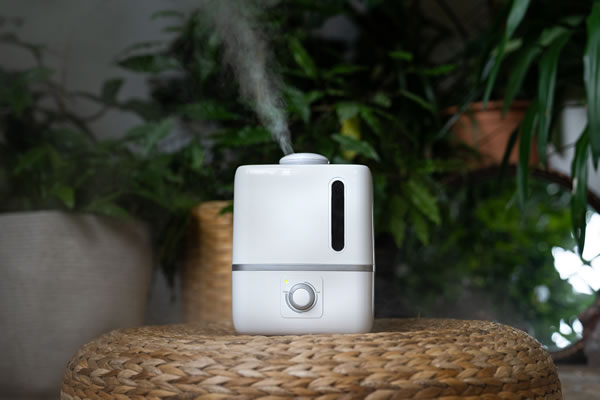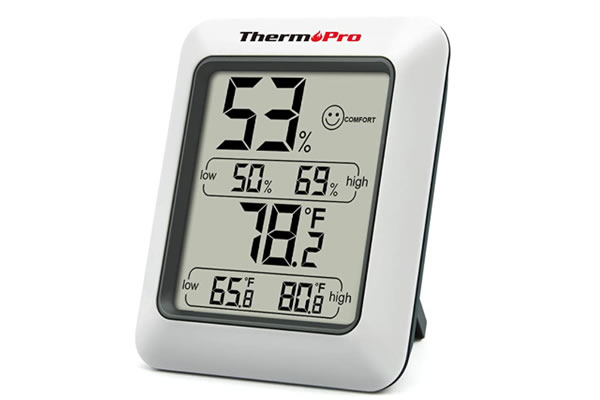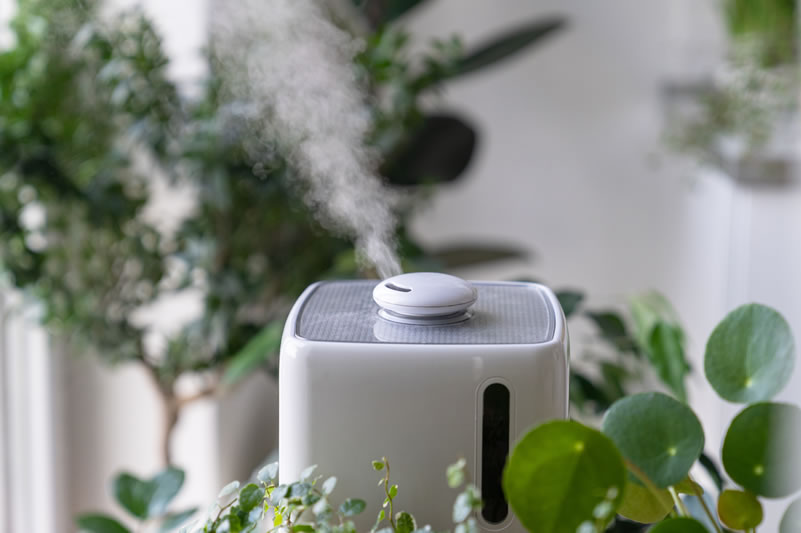A huge benefit for anyone into indoor gardening is the ability to carry on growing and planting during the long cold winter months.
Something our outdoor counterparts can’t compete with.
One topic many indoor gardeners find a problem time again is dealing with the reduced humidity the cold brings to our home.
During the winter months what’s the first thing we turn on – the heating!
The heat, created by fires and other heating sources, dries out the air and reduces moisture.
This isn’t good for your plants, so we need some way of increasing the moisture in the air and make your plants and vegetables happy again!
What Happens to Humidity in our Home in Winter
Plants can survive strong heat. Some of our indoor plants can be tropical and can take all the heat our homes in winter can dish out.
Unfortunately, the heat from our home has an additional affect that does impact our indoor garden, and that’s the humidity.
Humidity is the amount of water vapor in the air.
Our homes air conditioning units, and heating systems, all play a part in the amount of humidity in the air within our homes.
The ideal humidity should be between 30%-60% during the winter, depending on which plants you have, but the reality is this is often considerably lower in our homes due to the heat.
Plants need moisture.
Without moisture, or a reduction in moisture, you’ll find your some of your plants could wilt, discolor, shed leaves or shrivel.
Without preventative care you could find your plants not making it until spring, so it’s really important to keep a constant check on the humidity level in your home and adjust when necessary to reach the most ambient humidity levels for the types of plants you have.
How to Boost the Humidity for an Indoor Garden

There are a few ways you can boost the humidity in your home if you find levels are reducing:
- Mist your plant
- Get a humidifier
- Move your plants to rooms with more humidity
Mist Your Plants
Mist is full of water vapor, and plants love it – but just don’t overdo it.
Although it’s easy to keep misting your plants every day, this can start to have a negative effect.
Misting is great for a little moisture boost, but it shouldn’t be your only way to combat the drop in humidity levels in the home.
Get a Humidifier
Humidifiers are great for the home in winter.
It isn’t only plants that are affected by a lack of moisture and water vapor in the air. We humans are impacted too!
Humidifiers have come down in price recently, and the PurSteam 5L Humidifer from Amazon is a great choice to regularly boost the humidity in your home.
Give your indoor garden an early Christmas present – they’ll love you for it!
Move Your Plants to a Room with More Humidity
There are rooms in your home where humidity is always that little higher than other parts of the home, especially in winter.
Namely, the bathroom and kitchen.
The additional moisture in there can really help give your plants what they need.
It’s not uncommon to find indoor gardeners bathrooms full of plants in winter. This is often the reason why.
How to check if the Humidity in Your Home is Right
The water vapor in the air is invisible to the naked eye. It can’t be seen, and unless the humidity levels are extremely high (such as in fog) it can’t be felt.
Your plants if in a low humidity environment can show tell tale signs, but of course we don’t want to wait until it becomes a problem.
We want to be preventative rather than trying to find out how to bring an indoor garden back to life!
There are digital readers that can be purchased. These readers take a sample of the water vapor levels in the air and can give you a humidity reading.
The PurStream 5L Humidifier has such a built-in display (many humidifiers do not) which is why it’s a good choice but equally you may already have a humidifier or have other reasons for not wanting to invest in one.
You could opt instead for a humidity sensor.
Humidity Sensors

A humidity sensor measures the humidity level, and water vapor in the air, and allows you to keep a constant monitor.
These are great for indoor gardeners, and often can be purchased for around $10-$20.
I’d recommend the ThermPro TP50 from Amazon – it’s a great little device, easy to read display, continuously monitors the room and only costs around $11.
Light and Temperature Considerations
As well as the humidity in the room, you also need to consider the light source, and overall room temperature in the winter.
Although the sun will rise in the East, set in the West, and sits mainly in the South throughout the day – every day of the year – what you may or may not have noticed is that the sun rises and sets from different places.
If you watched a sunrise in March, and then went back in May to watch the sunrise again – it won’t rise in the same spot.
This is because the Earth is constantly tilting, which results in our season shift from Spring to Summer, to Autumn, to Winter but this shift means the sun doesn’t rise from the same place twice in a year.
This means you may need to move your indoor plants in your home.
Where your plant may have been getting an adequate amount of sun two months ago, may now not be as sufficient.
Check your plants position at the window and adjust if needed.
In the winter the temperature drops even more so at night. We are often tucked up underneath our warm duvet, but our plants have no such winter blanket.
Many indoor plants can comfortable, survive in temperatures down to 45F in winter but each plant is different.
As an indoor gardener you need to be aware of what temperatures your plants thrive in, and what temperatures they may struggle.
In Conclusion
It is important to make sure your indoor garden has everything it needs in all seasons.
Indoor plants thrive in the summer and will be used to hot humid temperatures and although they do not have to deal with the harsh winter environments outside, our need for heat in the winter can have a negative impact on our plants.
Keep the humidity levels at a good level and make sure you adjust the position of your plants so they can absorb as much as the limited sunlight levels as they can.
